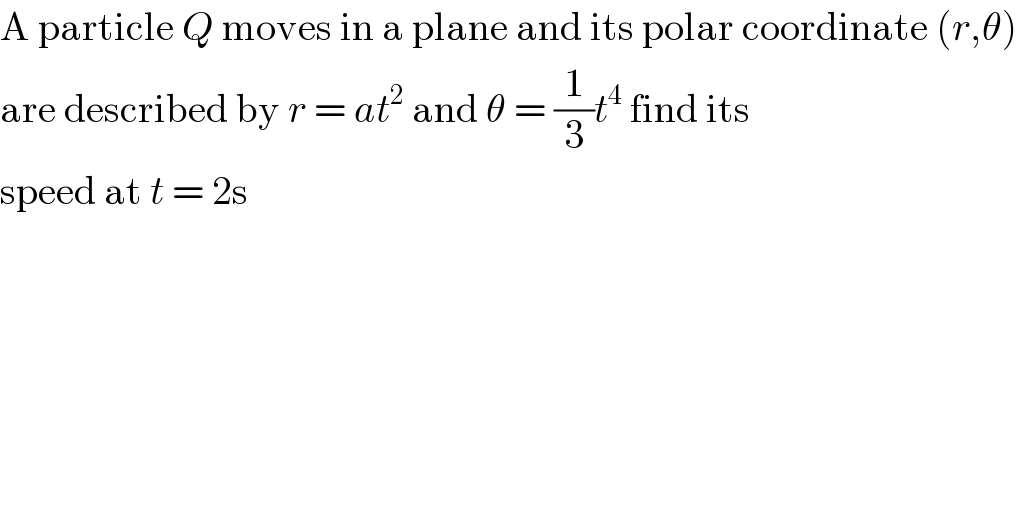
Question Number 99962 by Rio Michael last updated on 24/Jun/20

$$\mathrm{A}\:\mathrm{particle}\:{Q}\:\mathrm{moves}\:\mathrm{in}\:\mathrm{a}\:\mathrm{plane}\:\mathrm{and}\:\mathrm{its}\:\mathrm{polar}\:\mathrm{coordinate}\:\left({r},\theta\right) \\ $$$$\mathrm{are}\:\mathrm{described}\:\mathrm{by}\:{r}\:=\:{at}^{\mathrm{2}} \:\mathrm{and}\:\theta\:=\:\frac{\mathrm{1}}{\mathrm{3}}{t}^{\mathrm{4}} \:\mathrm{find}\:\mathrm{its} \\ $$$$\mathrm{speed}\:\mathrm{at}\:{t}\:=\:\mathrm{2s} \\ $$
Answered by smridha last updated on 24/Jun/20
![v^→ =r^• r^� +r𝛉^• 𝛉^� =2atr^� +(4/3)at^5 𝛉^� v^→ =[(dr^→ /dt)]_(t=2) =4ar^� +((128)/3)a𝛉^�](Q99970.png)
$$\overset{\rightarrow} {\boldsymbol{{v}}}=\overset{\bullet} {\boldsymbol{{r}}}\hat {{r}}+\boldsymbol{{r}}\overset{\bullet} {\boldsymbol{\theta}}\hat {\boldsymbol{\theta}}=\mathrm{2}\boldsymbol{{at}}\hat {\boldsymbol{{r}}}+\frac{\mathrm{4}}{\mathrm{3}}\boldsymbol{{at}}^{\mathrm{5}} \hat {\boldsymbol{\theta}} \\ $$$$\overset{\rightarrow} {\boldsymbol{{v}}}=\left[\frac{{d}\overset{\rightarrow} {\boldsymbol{{r}}}}{{dt}}\right]_{{t}=\mathrm{2}} =\mathrm{4}\boldsymbol{{a}}\hat {\boldsymbol{{r}}}+\frac{\mathrm{128}}{\mathrm{3}}\boldsymbol{{a}}\hat {\boldsymbol{\theta}} \\ $$
Commented by Rio Michael last updated on 24/Jun/20

$$\mathrm{thank}\:\mathrm{your}\:\mathrm{sir}. \\ $$
Commented by smridha last updated on 24/Jun/20

$$\boldsymbol{{welcome}} \\ $$
